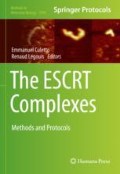Abstract
Budding yeast Saccharomyces cerevisiae is an ideal model organism to study membrane trafficking pathways. The ESCRT (endosomal sorting complexes required for transport) pathway was first identified in this organism. Upon recognition of endocytosed ubiquitinated membrane proteins at endosomes, ESCRTs assemble at these organelles to catalyze the biogenesis of multivesicular bodies (MVBs). Formation of MVBs leads to the trafficking of these membrane proteins to vacuoles for degradation. Here, we describe genetic and biochemical approaches to study ESCRT function. We outline in vivo endocytosis assays using two model cargoes in Saccharomyces cerevisiae and also describe an in vitro approach to analyze ESCRT-III polymerization on lipid monolayers.
Access this chapter
Tax calculation will be finalised at checkout
Purchases are for personal use only
References
Henne WM, Buchkovich NJ, Emr SD (2011) The ESCRT pathway. Dev Cell 21:77–91
Christ L, Raiborg C, Wenzel EM, Campsteijn C, Stenmark H (2017) Cellular functions and molecular mechanisms of the ESCRT membrane-scission machinery. Trends Cell Biol 27:1–11
Schöneberg J, Lee IH, Iwasa JH, Hurley JH (2017) Reverse-topology membrane scission by the ESCRT proteins. Nat Rev Mol Cell Biol 18:5–17
Menant A, Barbey R, Thomas D (2006) Substrate-mediated remodeling of methionine transport by multiple ubiquitin-dependent mechanisms in yeast cells. EMBO J 25:4436–4447
Guiney EL, Klecker T, Emr SD (2016) Identification of the endocytic sorting signal recognized by the Art1-Rsp5 ubiquitin ligase complex. Mol Biol Cell 15:4043–4054
Miesenböck G, De Angelis DA, Rothman JE (1998) Visualizing secretion and synaptic transmission with pH-sensitive green fluorescent proteins. Nature 394:192–195
Lin CH, MacGurn JA, Chu T, Stefan CJ, Emr SD (2008) Arrestin-related ubiquitin-ligase adaptors regulate endocytosis and protein turnover at the cell surface. Cell 135:714–725
Tang S, Henne WM, Borbat PP, Buchkovich NJ, Freed JH, Mao Y, Fromme JC, Emr SD (2015) Structural basis for activation, assembly and membrane binding of ESCRT-III Snf7 filaments. elife:e12548
Henne WM, Buchkovich NJ, Zhao Y, Emr SD (2012) The endosomal sorting complex ESCRT-II mediates the assembly and architecture of ESCRT-III helices. Cell 151(2):356–371
Tang S, Buchkovich NJ, Henne WM, Banjade S, Kim YJ, Emr SD (2016) ESCRT-III activation by parallel action of ESCRT-I/II and ESCRT-0/Bro1 during MVB biogenesis. elife 5:E15507
Chiaruttini N, Redondo-Morata L, Colom A, Humbert F, Lenz M, Scheuring S, Roux A (2015) Relaxation of loaded ESCRT-III spiral springs drives membrane deformation. Cell 163:866–879
MacDonald C, Payne JA, Aboian M, Smith W, Katzmann DJ, Piper RC (2015) A family of tetraspans organizes cargo for sorting into multivesicular bodies. Dev Cell 33:328–342
Prosser DC, Whitworth K, Wendland B (2010) Quantitative analysis of endocytosis with cytoplasmic pHluorin chimeras. Traffic 11:1141–1150
Teis D, Saksena S, Judson BL, Emr SD (2010) ESCRT-II coordinates the assembly of ESCRT-III filaments for cargo sorting and multivesicular body vesicle formation. EMBO J 29:871–883
Acknowledgments
Work in the Emr lab is supported by a Cornell University Research Grant CU3704. Sudeep Banjade is a HHMI fellow of the Damon Runyon Cancer Research Foundation (DRG-2273-16). Shaogeng Tang is a Merck fellow of the Damon Runyon Cancer Research Foundation (DRG-2301-17). We thank all members of the Emr lab for building these protocols in the lab over the years.
Author information
Authors and Affiliations
Corresponding author
Editor information
Editors and Affiliations
Rights and permissions
Copyright information
© 2019 Springer Science+Business Media, LLC, part of Springer Nature
About this protocol
Cite this protocol
Banjade, S., Tang, S., Emr, S.D. (2019). Genetic and Biochemical Analyses of Yeast ESCRT. In: Culetto, E., Legouis, R. (eds) The ESCRT Complexes. Methods in Molecular Biology, vol 1998. Humana, New York, NY. https://doi.org/10.1007/978-1-4939-9492-2_8
Download citation
DOI: https://doi.org/10.1007/978-1-4939-9492-2_8
Published:
Publisher Name: Humana, New York, NY
Print ISBN: 978-1-4939-9491-5
Online ISBN: 978-1-4939-9492-2
eBook Packages: Springer Protocols

